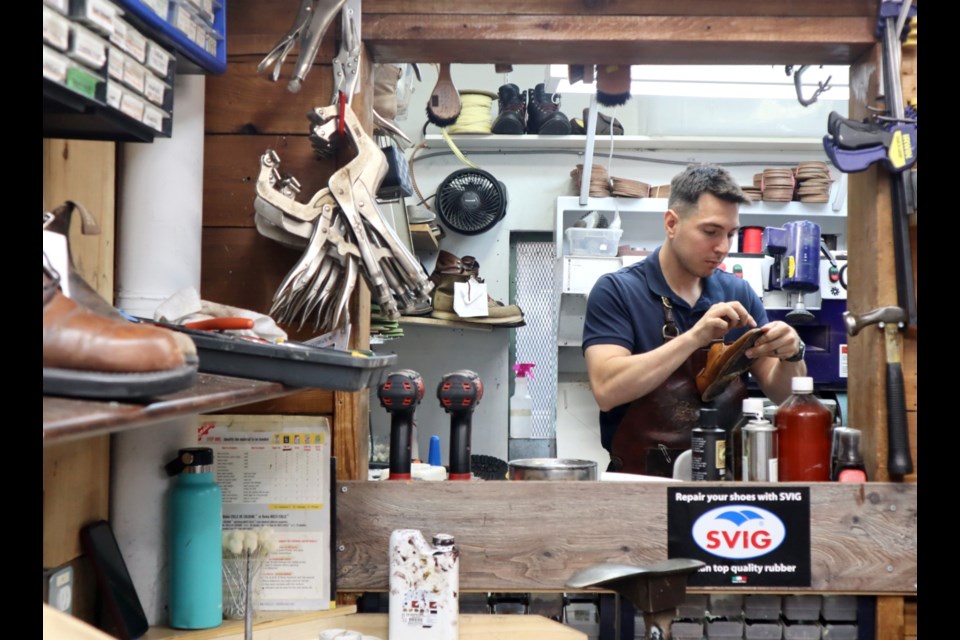Cobbling is a dying art but one Guelph cobbler is carrying the trade to the future.
Pablo Hadarits took over Dimar Shoe Repair on Quebec Street from his dad Diego when he retired in 2020.
Dimar has been around since 1987. The name chosen as a mix of Diego, and Marta, his mother-in-law. She grew up sewing and working with leather so it was a natural fit for her to go into business with Diego.
There used to be more shoe repair shops on Quebec Street. Diego learned the trade from an Italian shop owner at 13 Quebec St., who he eventually bought the business from.
Hadarits didn’t grow up in the shop. When he realized college wasn’t for him he asked his dad if he could work at Dimar and show him how to be a cobbler. He liked working with his hands.
He’s been a cobbler for nearly 20 years and this year he entered his first shoe repair competition. The inaugural Pimp that Shoe was put on by the Shoe Service Institute of America at its convention July 13 and 14. It’s a creative competition where cobblers can bring flair to a pair of shoes with no restrictions.
He has a friend who is a cobbler in Thunder Bay who also entered the competition. When Hadarits saw the shoes his friend repaired he was mesmerized and it motivated him to test his skills in a new way.
He found an old pair of classic Allen Edmonds dress shoes on eBay and got to work. It took him three weeks to finish. Competitors had to repair one shoe and leave the other shoe in the condition they found them in. It shows a clear before and after.
The shoes were creased and the sole was halfway through its lifetime. Hadarits massaged the shoe to get the creases out, and stuck it in a shoe tree to get back its original shape. The key to making the shoe last was reconstructing it with the Goodyear welt construction, where it’s stitched together on the outside of the shoe.
Hadarits dyed the shoe blue, resoled the bottom and added a red tongue, laces and stitching. He came in third place.
Hadarits learned a lot about cobbling from his dad and other cobblers worldwide through a Facebook group called Shoe Repair International.
“It's definitely a dying trade,” he said. “ But I feel like it's also more popular now than ever.”
There aren’t any cobbling programs or schools in Canada and he thinks there should be. It could attract more people to the trade. “If I ever get the opportunity where I could give back and help start a school in Canada, I would definitely love to,” said Hadarits, who was born in Argentina but has spent almost all his life in Canada.
At Dimar he takes in apprentices to show them the skills they need to become a cobbler.
“So I think that the demand for cobblers is very high. Just the supply is extremely low, and it's only going to get lower. I think the main reason is it's not a recognized trade. I think that has really hurt the industry,” he said.
Part of the hurt is the amount of synthetic shoes from overseas that flooded the market in the 80s. It has continued now with fast fashion where things are made cheaply and aren’t made to last.
What he thinks is helping the industry now is social media and cobblers showing their work through an extended reach online. Dimar is on Facebook, Instagram and YouTube. Hadarits shows his shoe repair process on his YouTube channel to show people the quality of work it takes to bring shoes back to life.
Social media has helped young people see shoe repair as a good trade to get into, he said.
The perception of what a cobbler is has changed too. Before people thought of a dirty, messy shop where an old cranky man sits and fixes shoes. “So I think now that people are seeing that there's artistry, there's a high level of skill, creativity,” said Hadarits.
Dimar has been so busy it had to stop accepting new clients for July as employees catch up on the backlog, training cobbler apprentices and reorganizing the shop. It’s set to reopen on Aug. 6.
There is one reason Hadarits thinks it’s been busy and that’s the environment. People are concerned about throwing out items that will end up in the landfill so instead they get them repaired.
He’s had customers bring in shoes under $50 to get repaired and the cost of the repair outweighs the cost of a new pair. “They are so insistent on us repairing it by any means. The price does not matter,” he said.
He thinks the reason being is because people are trying to keep a low carbon footprint.
Hadarits enjoys a challenge so when a pair of 150-year-old shoes came into the shop one day he was thrilled at the chance to repair them.
“I had never seen anything like this before. And they were extremely brittle. The leather was dried and cracked,” he said. He rebuilt the shoes and by the end they were beautiful again.
“Every layer we took apart was like a new discovery of an old world that is long gone.”
Another client climbed Mount Kilimanjaro and during the trek his shoes nearly fell apart. When he came back from his travels he brought his hiking boots to Hadarits to fix. Six months later he climbed the mountain again with the same boots.
The shop not only fixes shoes but belts, zippers, leather goods and knife sharpening. Hadarits restored a rifle case from the 1800s. No request is too strange. He’s heard everything.
